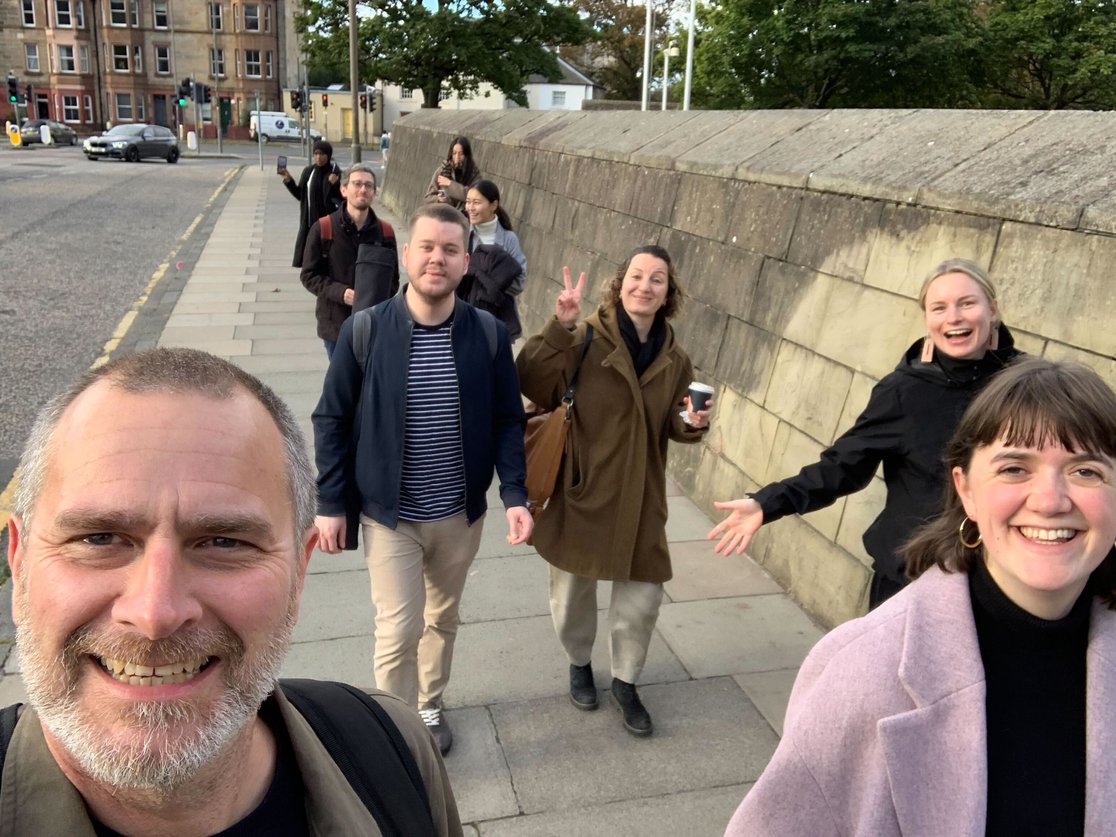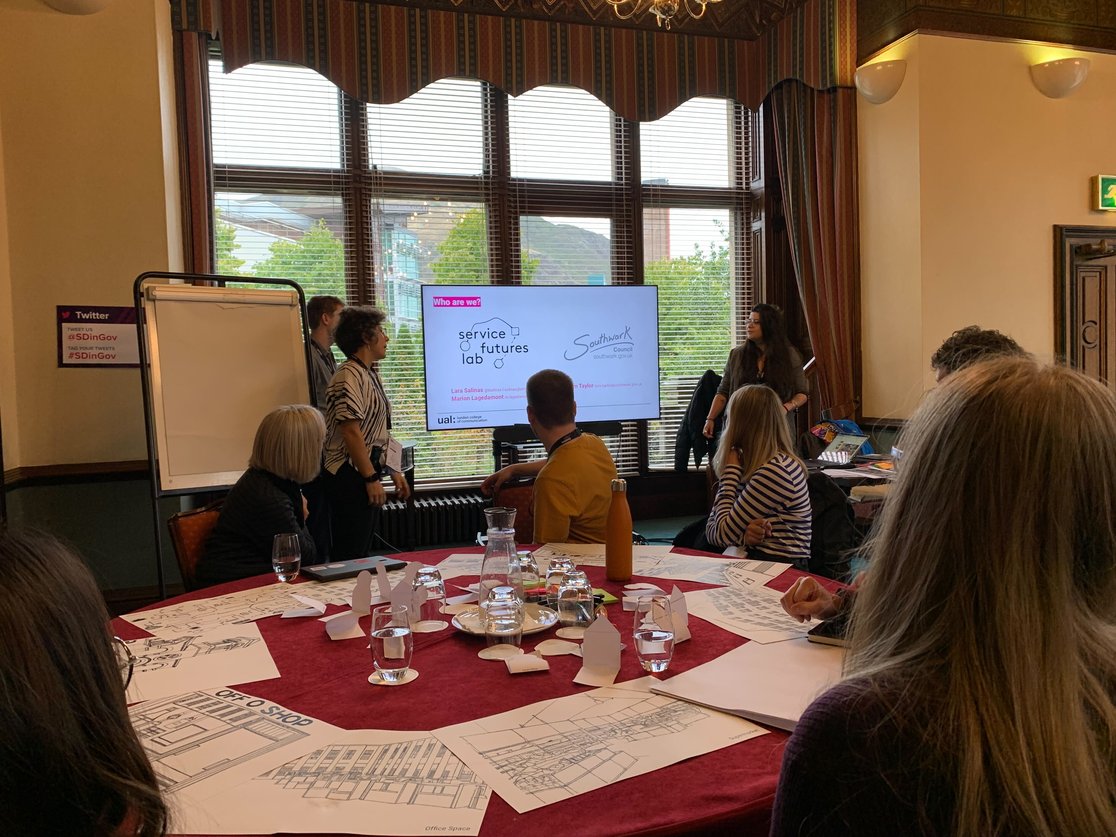From 28th to 30th September 2022, SDinGov returned for its 9th year and first in-person conference since 2020.
“I know some of my friends will be at the conference and it’ll be great to catch up after 2.5 years of pandemic”, said Mark Dalgarno on behalf of the whole organising team.
Eager to be part of the talks, workshops, discussions and case studies, a team of five Unboxed-ers headed up to the wonderful city of Edinburgh to attend the three-day conference. Here we’ve summarised thoughts and reflections from our time there.

Celia
As a first time attendee and a developer on top of that, I was unsure of what to expect at SDinGov. But I was surprised at how relevant the talks were to what I do, and how friendly and welcoming the community was.
I was particularly interested in the themes that arose around inclusivity and equity in design. And so Shabira Papain’s keynote on the second day was a great way to kick off thinking about it in more depth. She argued that when doing user research, start with the 20% of users that you think you aren’t going to be able to get in contact with, the ‘edge cases’. By doing so you make the services you’re designing better for everyone. She then talked about how to do research with those users in an ethical and respectful way.
Jess Kyriacou, Georgia Hill, and Millie Devreux presented a different lens on ethical service design - using friction in services. In the case of Homes for Ukraine they wanted to make it more difficult for hosts in the UK to sign up, so the hosts really understood the responsibility they would be taking on and to put off time wasters and those attempting to do harm. Design is so often focussed on making the user journey as smooth as possible, which is seen as a good thing. It was interesting to have this flipped around and think about when it is morally good to make the service harder to use.
Finally, the ethics of user research was raised again in a talk by Lindsay Green and Ana Wheelock about building a bereavement service in the Department of Work and Pensions. It involved talking to users who had lost a loved one very suddenly, and so are entitled to money from the government. They asked whether they should be talking to these people at all given they were so vulnerable, and if they did how to do it in a respectful and empathetic way. I felt emotional as they described doing this work during the pandemic, after a call with users who were upset “wiping our tears away and then going to tuck our children in”. It was inspiring and an amazing demonstration of how to conduct difficult work and produce a service that the users really appreciated.
Graeme
As a first time attendee of SDinGov, it was great to be able to attend in person. I’ve heard great things over the years about how wide and varied the conference programme is and how great the community is, and it was brilliant to have the opportunity to experience this.
I was drawn towards a lot of the sessions focused on exploring and solving big problems.
Pete Bates and Steve Borthwick from the Department for Work and Pensions talked about the end-to-end retirement journey and the work they’ve been doing to try to consolidate all of the different retirement scenarios. Different people go through very different circumstances when it comes to retirement. There are so many variables within an individual’s experience that it can be almost impossible to map a single journey and have it be applicable to someone else. It’s a very wide and varied landscape of what help can be offered and what support people can get.
Rehearsing sustainable futures was the topic for the most interactive workshop session that I attended. Dr Lara Salinas and Marion Lagedamonth from UAL and Tom Taylor from Southwark Council facilitated a session to look at the ‘art of the possible’ when it comes to what the world could look like if we were to become a carbon neutral society in the near future. The session was all about getting creative and thinking differently when it comes to solving this problem. In the future:
- could we be building houses in trees?
- is a pop-up local community hub, where everything comes to us instead of us going to it, the best way to reduce unnecessary mobility?
- are we repurposing old empty buildings for housing?
The questions were big and the ideas were creative, resulting in some very interesting discussions about potential solutions.

Finally, we facilitated a discussion session with LiveWork Studio, as part of the conference programme, titled ‘When service design hits a wall’. The format included a small group of attendees, two lightning talks and Lean Coffee-type discussion of prioritised topics. The conversation was fascinating. Hearing everyone’s different experiences and challenges really opened my eyes to what others are facing. Some themes discussed include:
- urgency versus collaboration: how can we focus on collaboration but also acknowledge time constraints?
- scepticism toward an answer because so many people have tried and failed
- interpretation of policy and the role of design in the creation process
- making procurement sustainable when commercial has such a deciding weighting in the process
Martyn
It's always great to be at SDinGov. Edinburgh is a beautiful city, the Service Design community is a welcoming and supportive bunch and the content is always stimulating. I'm taking away a few key themes and stand-out memories from my three days:
Policy and the way it is created, implemented, and assessed is still a major barrier to effective service design in government. Too often designers, and to a lesser extent researchers, are brought in at the implementation stage and have little input into the actual formation of policy. As a consequence, their impact is limited and the extent to which the desired policy outcomes are achieved is constrained. Liam Hawkes and Charlotte Moore from the Home Office Policy Lab gave me hope that things might be changing with their concept of ‘service ownership’, assigning a role to people who can bring together policy, operations and delivery in a similar way to how ‘product owners’ combine design, technology and business needs in the Unboxed model. I think we need to shift more towards service ownership in future if we are to deliver more impactful services.
I often hear design colleagues challenging the pace at which we move at Unboxed, suggesting that more time is needed for research and design before we start to create the (often digital) service. I completely understand their discomfort, especially given the complexity of the environments we work in, but it was refreshing to hear the different perspective of Chanelle Pal from DXW, who suggested that being expected to deliver work a little faster than you are comfortable with can in fact sharpen the mind and help focus on the essential and most valuable aspects of the task at hand.
I feel that as long as designers have enough insights to make informed decisions and have the ability to correct or improve their outputs through iteration, this is a valid perspective. However the linear, almost ‘waterfall’ nature of some projects makes this difficult to accept.
I was interested to hear from Caroline Kavanagh and Anne Bienia about the organisational restructure at Cancer Research UK and how they had gone about engaging and collaborating with stakeholders, effectively delivering ‘change as a service’. Embedding service thinking in organisations is something we've been invited to help with more recently. It's emerged from Ali Blake's research that one of the biggest barriers to successful design projects is organisational culture. It came up again in Ali's workshop with Liz LeBlanc from LiveWork along with many perennial favourites (don't get me started on procurement!) Culture change is always an important outcome of the work we do at Unboxed and I'm keen to make it a more explicit element in future.
Yasmeen
SDinGov was packed with interesting, inspiring and thought provoking talks, case studies and workshops this year. I’d like to reflect on three specific sessions that shared a common theme: the future.
Sometimes, in our focus on delivery, we don’t think enough about the future. I enjoyed Andthen’s Santini Basra’s session on the importance of visioning in supporting innovation. It was a good reminder that “long-term thinking helps us orient ourselves”.
Basra talked about the benefits of creating a vision: 1) for building culture and 2) for driving change; two of the main challenges I’ve faced when working on transformation projects. It was also helpful to hear about the challenges of building a vision which include, but are not limited to, cultural resistance to long-term thinking and finding the right altitude for a vision. Whether we’re helping clients design products, services or policies, visioning is definitely a good place to start.
In another future themed session, Bekki Leaver from SocietyWorks talked about how speculative design helped them make important decisions about an ASB (anti-social behaviour) reporting tool they were commissioned to build. Using co-design future casting, the team was able to anticipate negative unintended consequences on a specific group (the perpetrators of anti-social behaviour). By using this technique, the team decided against building the tool due to the negative impact it may have on this certain group in the future.
How do we tackle high complex challenges? How do we involve local actors? And how do we navigate uncertainty about the future? Dr. Lara Salinas and Marion Lagedamot from LCC together with Tom Taylor from Southwark Council shared a participatory design method to help us address these big questions. We were split into innovation units and tasked with designing net zero policies and services for the year 2030. It was so refreshing to see some of the ideas that came out of the session (see Graeme’s section above). The session made me reflect on the importance of play in unlocking creativity and seeing things differently.
Visioning, future-casting, and rehearsing sustainable futures are effective tools/methods that can help us address complex problems and help us predict unintended consequences to our designs. We need to make space for a more self-critical and holistic design approach in order to create more sustainable designs. To tackle the complex problems we are faced with today, we need to create space for creativity, playfulness and imagination and we need to take our clients along with us on the journey.
Find out more
We discussed the themes of service design with other members of Unboxed’s design team in our Thoughts Unboxed podcast titled ‘Is there a sweet spot for service design in local government?’ If you feel you have something to contribute, let us know using the social links below.
We’ve also been writing about the topic of service design in local government, with contributions from LocalGov Drupal, Hackney Council, DLUHC and others, in our blog post ‘Creating an environment for successful service design in local government’.

